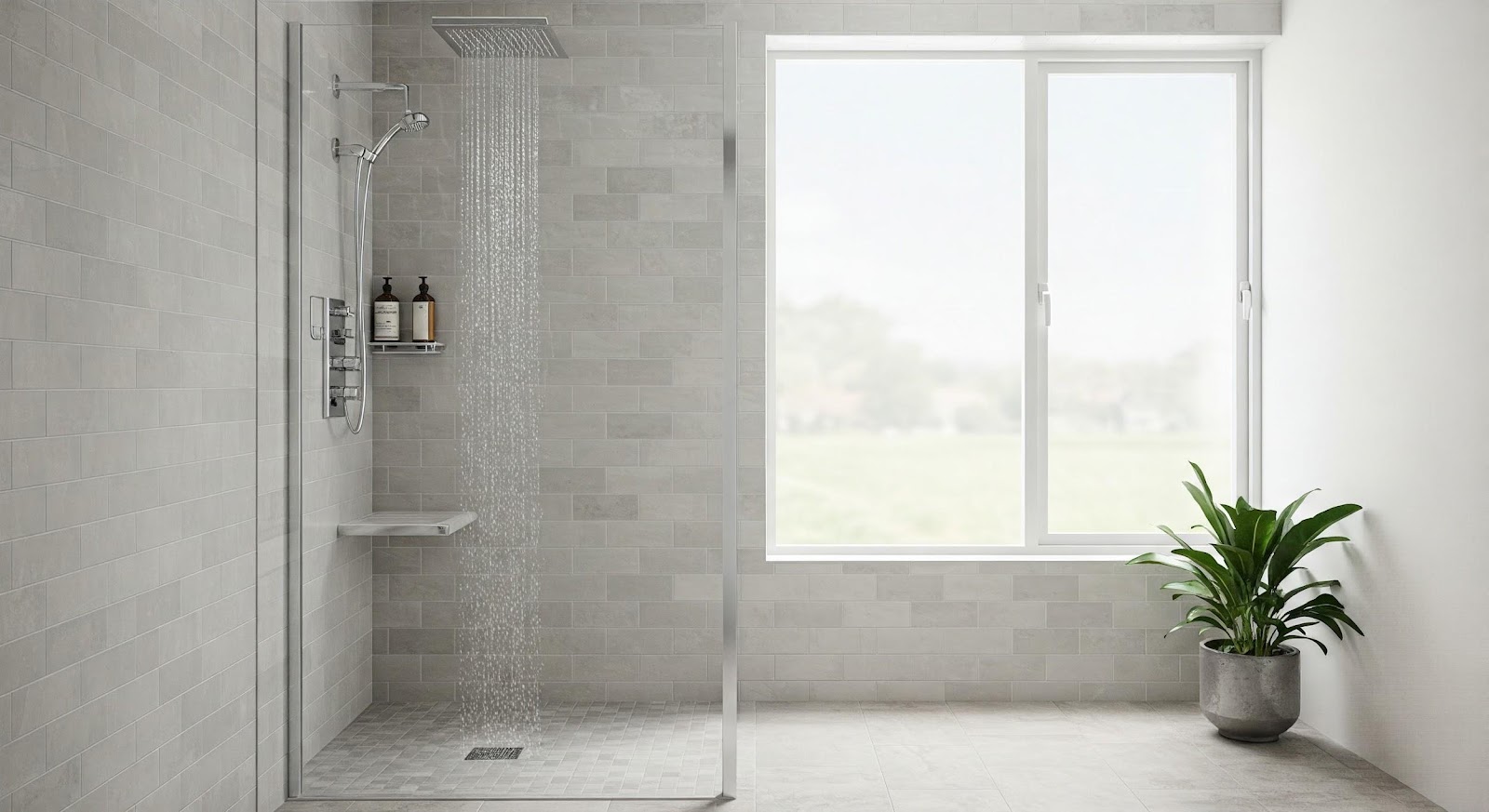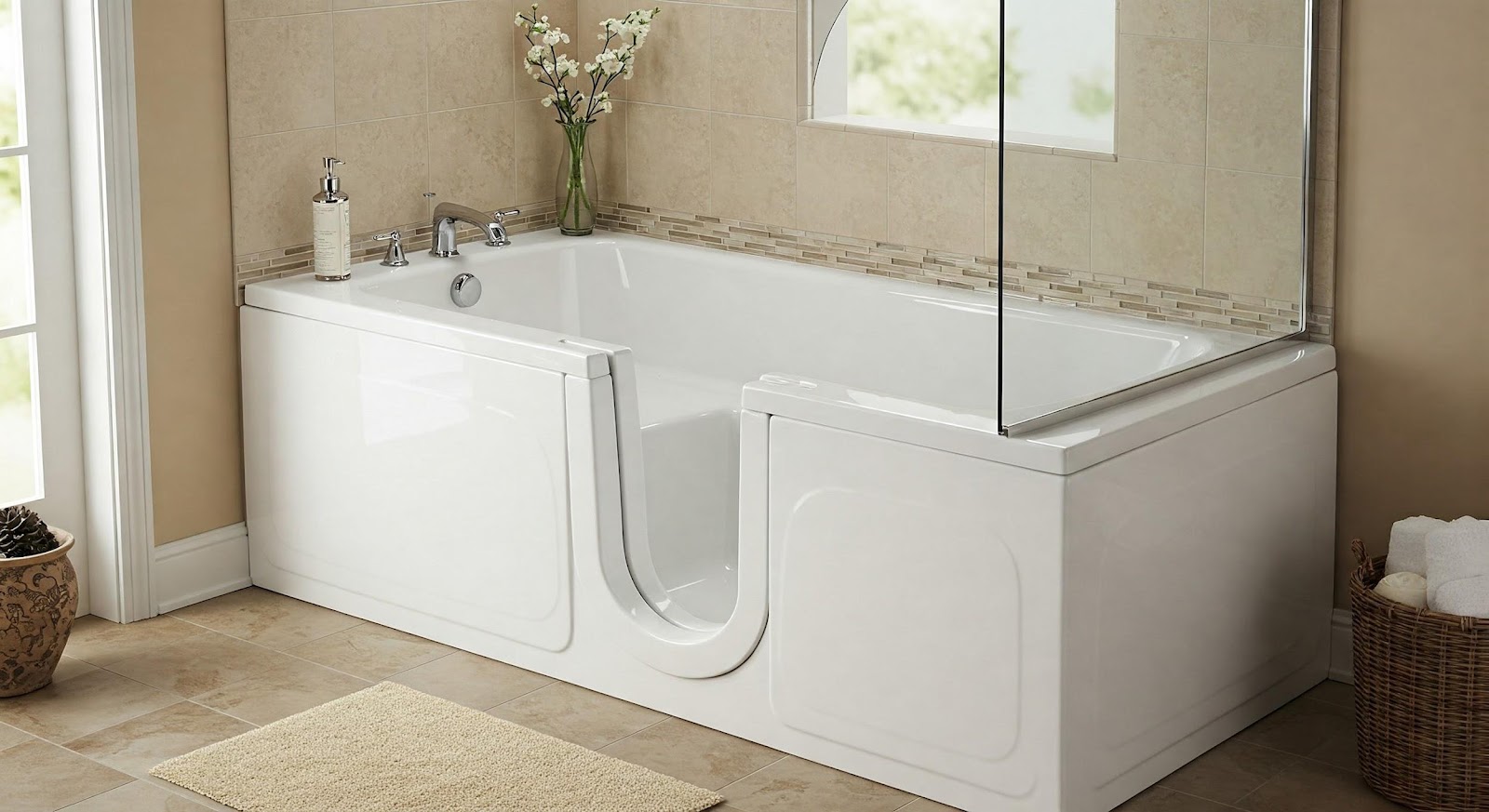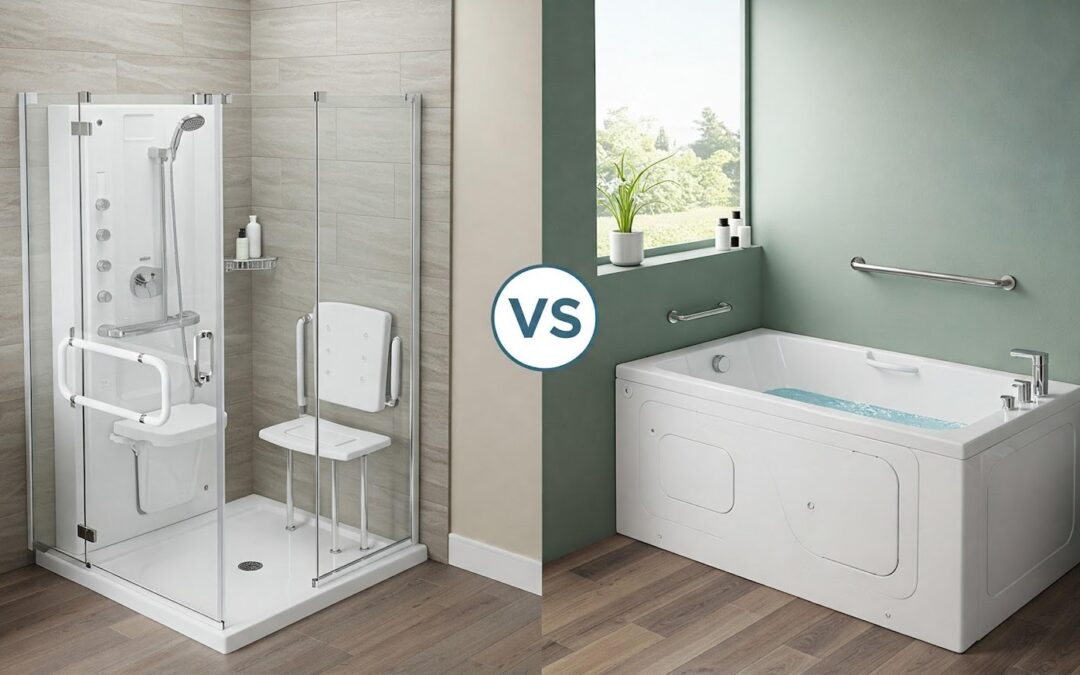A walk-in shower suits modern designs and smaller spaces, while a walk-in tub provides comfort and accessibility for those with mobility challenges. Both options offer practical benefits, but each comes with limitations that can impact daily use and long-term value.
This guide examines the strengths and drawbacks of walk-in showers and walk-in tubs, covering costs and essential considerations. With a clear understanding of both options, you can make a choice that enhances your bathroom’s functionality and meets your specific needs.
What Is a Walk-in Shower?

A walk-in shower is an open-access shower enclosure with no doors or curtains, providing easy entry and exit. The shower area typically features a level entry floor that eliminates the need for a step or threshold, making it accessible for individuals with mobility challenges, particularly wheelchair users.
According to the Centers for Disease Control and Prevention (CDC), approximately 80% of bathroom injuries are caused by falls, with the highest injury rates occurring among adults aged 65 and older. Walk-in showers can help reduce the risk of such injuries by providing easier access and minimizing hazards associated with traditional bathtubs.
Kurt from Kitchen & More suggests adding features like built-in benches, grab bars, and non-slip flooring to further enhance accessibility, as they have incorporated these elements in many of their bathroom projects in Bellevue. Waterproof walls and flooring will also contain the water spray, ensuring that the surrounding area remains dry and safe. Most walk-in showers use frameless glass panels to create an open, spacious feel while offering structural support without bulky frames. Common dimensions range from 36″ x 36″ for smaller spaces to 60″ x 42″ for larger bathrooms, making them versatile for various layouts.
Walk-in showers provide several practical benefits that appeal to many homeowners. Their design improves accessibility, saves space, and enhances the overall aesthetic of a bathroom. Key advantages include:
- Easy access for individuals with mobility challenges due to the barrier-free entry, reducing the risk of slips and falls.
- Space efficiency, making them suitable for small bathrooms where a traditional tub might be too bulky.
- Modern, open design created by frameless glass panels and minimal hardware, giving the bathroom a clean, contemporary look.
- Low-maintenance surfaces that simplify cleaning, with fewer corners and edges compared to tubs.
However, walk-in showers also come with potential drawbacks that should be considered before installation:
- Water splashing outside the shower area, which can lead to wet floors and safety hazards without proper drainage or splash guards.
- Limited suitability for families with young children or older adults who prefer soaking baths.
- Higher installation costs when plumbing modifications or custom glass enclosures are needed.
What Is a Walk-In Tub?

A walk-in tub is a deep soaking bathtub with a watertight door, allowing users to enter without stepping over a high edge. These tubs include a built-in bench seat that keeps the torso and lower body submerged while seated. Standard dimensions range from 60 inches long by 32 inches wide to 60 inches by 40 inches, making them suitable for larger bathrooms.
Many walk-in tubs include handrails, non-slip floors, and low thresholds, providing enhanced safety for individuals with limited mobility. Some models also offer hydrotherapy features such as air or water jets for muscle relaxation and pain relief.
Walk-in tubs provide several advantages that make them appealing for homeowners needing accessible bathing solutions:
- Built-in safety features such as grab bars, non-slip surfaces, and low-entry thresholds reduce fall risks during use.
- Accessible design makes walk-in tubs ideal for individuals with significant mobility challenges who struggle with traditional bathtubs.
- Therapeutic benefits from optional hydrotherapy and whirlpool jets help alleviate muscle tension, arthritis pain, and circulation issues.
However, walk-in tubs also come with notable disadvantages that should be considered before installation:
- High initial costs, depending on the model and features included.
- Increased water usage due to the larger size, along with longer fill and drain times, which can be inconvenient for daily use.
- Space requirements that may limit their suitability for smaller bathrooms, especially when additional plumbing or electrical modifications are needed.
Cost Comparison: Walk-In Shower vs. Walk-In Tub
Walk-in showers cost between $6,000 and $12,000 on average, depending on materials, labor, and design complexity. Prefabricated units start at around $1,000, while custom installations with tiled floors, frameless glass panels, and premium fixtures can exceed $15,000. Additional costs include demolition ($450 to $2,000), new plumbing, and shower doors ($300 to $2,500), making the final price highly dependent on the chosen features and bathroom layout.
The cost of walk-in tubs ranges from $4,000 to $32,000, depending on size, features, and materials. Standard units average $3,100, while luxury models with advanced features like whirlpool jets can reach $20,000 or more. Labor for plumbing adjustments and electrical work can significantly impact the final price. Walk-in tubs also use more water, potentially increasing utility costs over time, while walk-in showers reduce water usage, making them more energy-efficient in the long run.
Which Option Is Right for You?
Walk-in showers suit small bathrooms where space is limited. The open design, often with a zero-threshold entry, allows wheelchair users to enter directly, making them a practical choice for individuals with mobility aids. Built-in benches, hand-held showerheads, and strategically placed grab bars enhance safety without compromising accessibility. Showers also use less water than tubs, reducing utility costs over time.
Walk-in tubs provide safer bathing for individuals with limited mobility who prefer soaking. Tubs with 15-inch seat heights and low-step entries (3 to 7 inches) support users who cannot stand for long periods. Hydrotherapy jets help alleviate muscle pain and improve circulation, making them beneficial for seniors and those with chronic conditions. However, tubs require more water, often needing 50 to 80 gallons per use, and take longer to fill and drain, which may affect daily routines.
Make an Informed Choice for Your Bathroom Remodel
Key factors to consider include bathroom size, budget, user needs, and long-term convenience. Smaller bathrooms benefit from the space efficiency of walk-in showers, while larger spaces can accommodate the size and water capacity of walk-in tubs.
Installation costs also vary, with walk-in tubs generally being more expensive due to additional plumbing and electrical requirements. Consulting with a professional bathroom remodeling contractor and evaluating your current needs, future mobility, and financial considerations will help determine the best option for your home.

Recent Comments